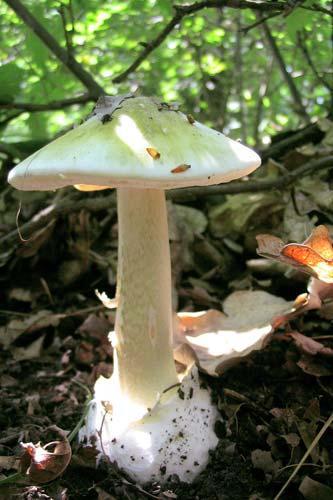How poisonous mushrooms look like pale toadstool in the photo: how to distinguish them?
Consider what a pale toadstool looks like: a cap from ovoid to flat-convex, with age, prostrate, slimy or dry, 6-12 cm in diameter, greenish to yellowish-olive, usually with dark, ingrown fibers, rarely almost white or dark - olive brown. At a young age, white flaky warts are scattered on the surface of the cap, which disappear in adult fruiting bodies or after rain. The pulp is white, rather thin. The plates are wide, white. Stem 10-15 X 1.5-2 cm, cylindrical with a tuberous-expanded base, white, yellowish or greenish, smooth or with scales. Volvo is cup-shaped, wide, free (not adhered to the stem by the edges, as, for example, in the red fly agaric), white, usually torn at the top into 3-4 parts (blades). The ring is white, slightly striped from above, usually erect, in the upper part of the leg. The smell and taste (at least in young mushrooms) are very pleasant. In old mushrooms, the smell becomes sweetish and unpleasant, like crushed insects.
The following shows what a pale toadstool looks like in the photo, illustrating the various forms:
The pale grebe is quite thermophilic by our standards and prefers deciduous and deciduous forests. The favorite habitat of this fungus in the European part of Russia is lime and oak forests. The green fly agaric is found throughout the taiga zone, but still feels better in the south. The most comfortable conditions for the pale toadstool are in the forest-steppe zone (for example, the Volga region, Ukraine, etc.). On the other hand, the heat-loving grebe leads to the fact that in our places it definitely gravitates towards forest suburbs and summer cottages, "capturing" additional crumbs of heat from cities and other human settlements.
The poisonous pale toadstool bears fruit from July to early October.
In our forests, at a young age, poisonous toadstool mushrooms can be confused with edible fly agarics and some champignons. There are known cases of collecting pale toadstools instead of russules with green caps or rowers-greenies, when the pale toadstool was cut very high, right under the very cap, which made it impossible to find a ring and a bag when bulkheading mushrooms at home. It is believed that it can be confused with an adult champignon and even an umbrella. How to distinguish pale toadstool from completely edible types of mushrooms and get this dangerous mushroom in a basket?
Consider further, but for now it is proposed to look at the poisonous pale toadstool in the photo:
The pale toadstool has a white (albino) shape when the entire mushroom is entirely white. In this case, it is very difficult to distinguish it from the deadly stinking fly agaric (Amanita virosa).
In the world there is a pale toadstool, with which they just do not confuse. This is explained, on the one hand, by a rather low culture of mushroom-picking, mixed with great enthusiasm, and on the other hand, by the fact that the pale grebe is a young immigrant, not yet sufficiently studied by local mushroom pickers. So, for example, recently there have been reports of cases of fatal toadstool poisoning among immigrants from South and Southeast Asia who settled in Australia and on the west coast of the United States. Poor Asians confuse the scary fly agaric they have never seen before with their favorite straw mushroom (Volvariella volvacea, widely cultivated in Asia). Several years ago, the BBC aired a story from Oregon in which four similarly embarrassed members of a Korean family managed to survive with liver transplants. Of the seven people who died from the pale toadstool between 1991 and 1998 in Canberra, Australia, six were former Lao citizens.
Foreign novice mushroom pickers often confuse young fruit bodies of the pale toadstool with edible raincoats, which have not yet broken the common veil, and mature fruit bodies with edible local amanita species (for example, American A. lanei) or green-colored russula and rowers.
Symptoms and signs of poisoning

Toadstool poisoning is dangerous because signs of the ingress of toxic substances into the body do not appear immediately. The first symptoms of poisoning can occur only after 30-40 hours.
The first symptoms of poisoning are acute pain in the stomach and intestines, upset stools, vomiting. Diarrhea and vomiting are so frequent that drugs cannot stop them. Watery, yellow-green diarrhea.
After 2-3 days, the symptoms of poisoning may disappear, as if the toxic mushroom had not been consumed. However, the consequences of the ingestion of poison in the body quickly make themselves felt. Within a day, the pains return, vomiting and diarrhea again occur.
The effect of the poison on the human body
There are several stages of the action of a toxic fungus on the human body:
- Latent period. Lasts up to two days. There are no signs of poisoning at this time. However, during this time, toxic substances have time to penetrate into the bloodstream and begin their destructive effect on the internal organs. This time is also called the incubation period.
- Manifestation of symptoms. The fact that the body is affected by a toxic toxic substance is signaled by acute pain, frequent vomiting and diarrhea, since the poison causes inflammation of the mucous membrane of the stomach and small intestine. And also this period is characterized by severe dehydration of the body, against the background of which blood pressure decreases. The patient feels severe weakness, dizziness. During this period, convulsions and loss of consciousness often occur. Symptoms of intoxication manifest themselves within 1-2 days.
- An imaginary lull. For a short time, all signs of intoxication disappear. The patient thinks that he is on the mend, but this is only an appearance. This stage of poisoning is dangerous because if a large amount of a poisonous substance enters the body, sudden death can occur. The stage of imaginary lull lasts no more than 12 hours.
- Damage to the parenchymal organs. Toxins have a destructive effect on the liver, therefore, during this period, severe pains appear in the right side. Symptoms are similar to those of kidney failure. This stage is characterized by the presence of yellowness of the skin, mucous membranes of the mouth and eyes.
The lethal dose for an adult is a third of a mushroom cap. If this amount of poison has entered the body, then death occurs as a result of acute heart failure and deep damage to the kidneys and liver. A lethal outcome can occur within a week, and in the absence of timely treatment, already on the first day. But if the patient received medical attention on time, then after a few weeks the signs of intoxication disappear without a trace, and the internal organs affected by toxins are completely restored.
Pale toadstool description
A young toadstool has a body that is shaped like an egg. Growing up, the mushroom becomes the owner of both the legs and the cap, covered with a film.
The color of the cap of a pale toadstool can be light gray or olive, light green. It is flat, the edges are smooth, and the surface is fibrous. The diameter of the cap can be from 5 to 15 cm.
If such a mushroom is cut off, then the places of damage do not change color, they remain white. The smell and taste of a toadstool is very weak.
The color of the leg, usually repeats the color of the cap, it is just white, and its shape is like a cylinder, thicker at the base. The length of the leg reaches 16 cm, and the maximum width is 2.5 cm.
The toadstool has white plates. They are quite soft and free. A young mushroom has a large ring with fringes and stripes, but gradually, with age, it usually disappears.
This mushroom is equipped with a Volvo. It is very noticeable, white, lobed.Its width is about 5 cm, and part of it is submerged in the ground. There is no coverlet on the cap, but there are scraps of dense films.
Description of pale toadstool
Hat. The diameter of the cap of a pale toadstool is up to 14 cm. More often it is up to 10 cm. Its silky skin is greenish-olive or grayish-green in color. The center of the cap is often slightly darker and the edges are lighter. The skin is usually smooth, less often scales are visible on it, which are the remnants of the bedspread. Young mushrooms have a convex cap, which becomes flat-convex or outstretched as it grows. The plates are white. The pulp is white, greenish under the skin. There are gray toadstools of a rarer white form.
Leg. The length of the leg of a pale toadstool can be up to 20 cm, the thickness is up to 2 cm. The color of the leg is white, greenish-yellow streaks, stains or patterns are clearly visible on it. The leg is widened at the bottom. The pale toadstool has several distinctive features that help identify this scary mushroom.
Mushroom pickers should be alerted by a whitish ring in the upper part of the leg, which is solid, torn or inconspicuous, like flakes. It is formed from the film covering the plates of young pale toadstools. The Volvo cup, torn into three to four blades at the appearance of a young mushroom, should also scare off. Volvo is at the bottom of the leg (near the ground). The leg does not adhere to the Volvo, it seems that it is inserted into it. The color of the outside of the Volvo is whitish, yellowish or greenish. One gets the impression that the saccular cup of the Volvo is prepared "for growth."
Pale toadstools are moisture-loving, in rainy weather they appear in large numbers as whole "plantations". In the arid regions of the country, pale grebe is much less common. The fungus grows more often in deciduous and mixed forests. But this does not exclude its appearance in conifers. Especially in pine forests, where there is a lot of sphagnum moss.
The pale grebe appears from June. The peak of its growth is observed from the second half of August to mid-September.
Pale toadstool twin mushrooms
If all the pale toadstools looked "like in the picture", then there would not be so many people who put this poisonous mushroom in their basket, and then in a frying pan.
Russula is green and greenish. The green variety of the white toadstool is often confused with the very common russula. The main differences are the absence of a ring on the white leg of the russula. The legs of the green and greenish russula have no scales and patterns. There is no volva at the base of the russula leg.
Greenfinch. The green leaves are lemon-colored, and in the pale toadstool they are white. Greenfinch is a stocky strong mushroom. The pale toadstool is completely different.
Float. A white toadstool (fortunately more rare) can be easily confused with a float. Even experienced mushroom pickers have mistakes with these mushrooms. For novice mushroom pickers, a white float is at risk.
Champignon. The pale toadstool is sometimes called the "false mushroom". Young mushrooms are more difficult to deal with.
The stinking fly agaric (Amanita virosa), or the white toadstool, which grows closer to the North, is also a deadly poisonous mushroom-counterpart of the pale toadstool. In the Moscow region, there is a lot of it in dry years. In the Far East, the white grebe grows in spruce and fir forests. Amanita would not be worth remembering if there were no similarities between the pale toadstool, the stinking fly agaric and the white float.
Amanita mappa also resembles a pale toadstool. But he has a volva attached to the leg and flakes of the parts of the bedspread remaining on the cap. This inedible mushroom was previously considered poisonous due to the presence of the toxin bufotenin in its tissue. Amanita muscaria replenishes the list of twin mushrooms of the pale toadstool, but does not cause any desire to put the mushroom in the basket.
Pale death
Pale toadstool (lat.Amanita phalloides) - a mushroom from the genus of fly agaric, deadly poisonous - its use is often fatal. It is said that the Roman emperor Tiberius Claudius was poisoned with a mushroom dish, which, by order of his wife Agrippina, was prepared from the green fly agaric - the pale toadstool. The most dangerous poisonous mushrooms The emperor, who suffered from a poisonous mushroom, is not alone: legends say that the ancient Greek playwright Euripides was poisoned by pale toadstools. And also - Pope Clement VII, one of the four Popes from the Medici family. History is silent about ordinary citizens who "played in the box" by eating this mushroom. According to modern statistics, every fourth child and every twentieth adult dies from the venom of the pale toadstool. Only about 30 grams of pulp can be fatal - about a quarter of the usual size of Amanita phalloides. Toxicity depends on the region of growth, as well as on the weather - the number of rainy and sunny days. Poisons of the pale toadstool - amanitins, phalloidins and amanin - produce hepatonephrotoxic (on the liver and kidneys) effects and are not destroyed by any heat treatment. In total, scientists have isolated about a dozen different toxins from Amanita phalloides, and the effect of many of them on the human body is far from fully understood. Insidious amanita phalloides In case of poisoning with pale toadstool, symptoms appear only a few hours (and sometimes even days) later, when gastric lavage is already useless to do, and the poisons have done their dirty work
Then, on the second or third day after the onset of symptoms (indomitable vomiting and diarrhea), patients experience a period of "false well-being", during which irreversible destructive changes occur in the kidneys and liver. Therefore, it is extremely important to go to the hospital immediately, at the first suspicion of poisoning, not hoping to "lie down".
Stages of development of a pale toadstool. And it is better to never pick mushrooms in which you are not one hundred percent sure.
How to distinguish the pale toadstool from, for example, russula and champignons, is described in the article Top 10 Poisonous Mushrooms, which definitely should not be put in the basket.
How to recognize toadstools?
The fruit body of a toadstool is represented by a cap and a leg, but at a young age it resembles an egg and is completely covered with a film. Some people manage to confuse a toadstool in this form with a raincoat. Recall that the fruiting body is that part of the fungus, which we in everyday life call the fungus.

The hat can be sized between 5 and 15 cm in diameter. Gray, greenish and olive-colored. Shape: flat, hemispherical. The edges are smooth and the surface is fibrous.

The pulp (inner content) is white with a fleshy content. In case of damage, color change does not occur.

The height of the leg ranges from 8 to 16 centimeters, and the diameter is from 1 to 2.5. There is a thickening in the form of a pouch at the base. In color, either does not differ from the cap, or is whitish. Moiré patterns are often present.

The plates are radial growths on the lower part of the cap, diverging from the stem. White, soft, loose. On the leg there is a characteristic skirt, scientifically called “ring”, which can disappear with age. It is wide, as if with a fringe. When viewed from the outside - striped.





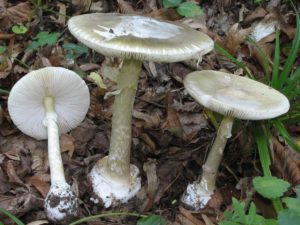
There is a developed Volvo, partially submerged in the ground. Volvo is like the remnant of an egg from which a mushroom hatched. It is characterized by a white color. Free-bladed. The width is usually 3 to 5 centimeters.

The spore powder is white.


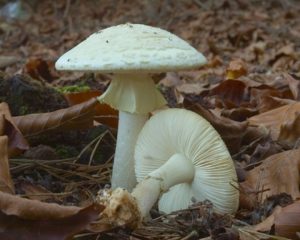



A bit of history
For the first time, the French biologist Sebastian Vaillant came to the study of Pale Toadstools. Subsequently, he gave the name Amanita phalloides to a poisonous mushroom from the fly agaric family. If you analyze the name, then in translation it combines two meanings at the same time.Amanita is a fly agaric, and felloidiz, oddly enough, denotes male dignity - apparently it was with these aspects that the scientist got the Pale Toadstool.
Of course, not everywhere she was called exactly as most people were used to. For example, in 1727 in England it was nicknamed the Death Hat because of its strong poison, which can deprive a person of vitality even in small doses.
Where grows
The place of growth of amanita phalloides is deciduous and mixed forests of Eurasia, Asia and North America. It practically does not occur in coniferous forests. This is explained by the fact that the toadstool prefers fertile soils, and coniferous sandstones are not suitable for it. Most often, poisonous mushrooms can be found at the foot of oak, hazel, beech and birch trees.
They bear fruit regardless of whether they grow singly or in groups. Fruiting time from August to November. This explains the fact that the mushroom is more common in August.
Where it grows in Russia
The pale grebe in Russia grows in places with a temperate climate. Since she prefers fertile moist soils, she can often be found not only in the forest or in the park, but also in household plots.
 Most often, pale toadstool occurs in August.
Most often, pale toadstool occurs in August.
Description
To avoid poisoning, it is best to follow the "golden rule": do not pick mushrooms that you do not know. Even one poisonous mushroom, accidentally trapped in a basket and processed along with edible ones, can cause poisoning. Inedible and poisonous mushrooms, similar to edible ones, have distinctive features.
Distinctive signs: a hat with a diameter of 5 to 15 cm, first bell-shaped, then slightly convex, silky, white, pale green, yellow-green or olive-green; the color in the middle of the cap is usually darker - to olive-brown, without flakes on the surface; the plates are white, the leg is up to 15 cm long, up to 2 cm thick, thickened at the base, white or greenish, with a membranous ring, at the base with a saccular sheath; the pulp is white, without any special smell and taste.
Where grows
The pale grebe is found in places in abundance, especially in the southern strip of the forest zone, from June to October. Loves fertile soil, grows more often in mixed and deciduous forests among oaks, beech and hazel. Habitat - Europe, Asia and North America.
Seasonality: late summer - autumn.
Similarity to champignon

Inexperienced mushroom pickers sometimes confuse pale toadstool with edible champignon. It must be remembered that in the champignon, in contrast to the poisonous pale toadstool, the plates are pink, light brown or blackish; there is no saccular sheath at the base of the leg; the leg is shorter.
Similarity to a green russula

Sometimes the pale toadstool is confused with the green russula. The russula has no thickening at the base of the peduncle, and there is no membranous ring in the middle of the pedicle.

Mushrooms floats are smaller in size, they have thinner flesh, there is no ring
Poisonous toadstool poisoning
Poisoning occurs when mushrooms are eaten, and during heat treatment, the toxic properties are not lost. By eating 1/4 of the mushroom or 30 g, you can already get severe poisoning. For children, such poisoning can be fatal.
Approximately 2 days after poisoning - vomiting, muscle pain, thirst, diarrhea with blood. Sometimes jaundice develops, the liver enlarges. Pulse weakens. Blood pressure drops, loss of consciousness may occur.
It is important - the symptoms of poisoning may not appear for a long time, the primary signs appear after 6 - 24 hours, but all this time, irreparable damage has already been caused to the body. Another characteristic feature - on the 3rd day, a false well-being syndrome occurs, it can last 3-4 days
Death usually occurs within ten days
Another characteristic feature is that on the 3rd day, a false well-being syndrome occurs, it can last 3-4 days. Death usually occurs within ten days.
What to do in case of poisoning with a false toadstool
At the first symptoms, it is necessary to urgently go to the hospital to carry out antitoxic therapy.
If you start treatment no later than 36 hours after poisoning, then the prognosis is favorable. It is worth treating everyone who could use this mushroom.
General detoxification measures before an ambulance arrives:
- all those taking mushrooms drink 2-3 liters of warm water, try to induce vomiting, you can press on the root of the tongue.
- drink activated carbon (1g per 1kg of weight)

Lightinthebox 979 R.
Toadstool poisoning
The main active ingredient of the venom of the pale toadstool is alpha-amanitin, which has a peptide nature. When taken orally, it surpasses potassium cyanide in toxicity by almost 17 times.

Unlike cyanides, it is a cytotoxic poison and does not act instantly, but with a delay of about 10 hours, or even a day. The first symptoms: diarrhea, vomiting. It is clear that in a day you will not get off with gastric lavage, since alpha-amanitin circulates through the body with might and main.

By acting on the RNA polymerase-2 enzyme, it disrupts the synthesis of proteins in the cell, which leads to its death. The liver and kidneys are the most affected. Even if the victim managed to survive (approximately 15% of the poisoned die), then, most likely, he will need a liver transplant, which in the conditions of the CIS countries is akin to a death sentence.


Remember that no culinary (including heat treatment) reduces the toxicity of the pale toadstool. Do not touch the mushroom with your hands. It is unacceptable for him to come into contact with edible mushrooms.

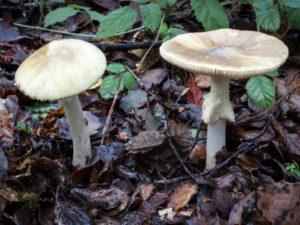





How to get rid of the pale toadstool in the garden?
If a toadstool appears in the garden, in the garden or in another place of the personal plot, you need to remove it as soon as possible in order to free the cultivated plants from the unwanted neighborhood. The toadstool must be pulled out along with the root and destroyed.
If a group of poisonous mushrooms is found, then they should be pulled out. Then, to get rid of the mycelium, raise the top layer of the earth and, if possible, remove the mushroom threads. If this is problematic, then leave the layer of earth in an elevated form for several days. The sun's rays will completely destroy the remnants of the root system of the mushrooms. Then dig up the place where they grew. If there are too many of them, then you will have to deal with them with the help of special garden chemicals.
 Pallid toadstool needs to be pulled out along with the root
Pallid toadstool needs to be pulled out along with the root
To prevent the appearance of a green fly agaric in the garden in the future, the area should be cleaned of rotten and rotten wood. It is necessary to periodically remove weeds and tall grass from the site in order to avoid the appearance of darkened wet areas that poisonous mushrooms like so much. In those places where a toadstool was once discovered, you need to periodically loosen the soil.
Pale toadstool in folk medicine
Toadstool poison for medicinal purposes is used by homeopaths as an antidote for poisoning with inedible mushrooms. However, this dangerous antidote is rejected by traditional medicine, since the use of a drug based on the toxic substance of the toadstool is questionable, despite all its positive characteristics. Accidental poisoning if the dosage is not followed - and the poison of the pale toadstool will be fatal.
Poisonous mushroom against cancer
Traditional medicine has so far rejected the possibility of using amanita venom for the treatment of cancer in humans. Yes, such experiments have not been carried out. However, German scientists are working in this direction, who conduct research on mice. The animals were injected with a toxic substance extracted from the fungus. Some cancers resolved after a few shots. Despite the success of the tests, doctors are in no hurry to use the poison of a dangerous fungus to treat a person.
It was proved that, in addition to the poison secreted, amanitin was also isolated from the pale toadstool. It is a deadly poison that can destroy cancer cells and prevent the development of metastases.One injection is enough to suppress the growth of cancer cells in mice.
Edibility
Pale toadstool is deadly poisonous and not used for food. Moreover, not only the body of the fungus is poisonous, but even the mycelium and spores! Therefore, it is better not to pick berries, herbs and other mushrooms near the places of its growth.
During any processing - drying, frying, cooking, freezing and other possible and impossible treatments, the poison does not lose its strength. A small piece is enough for poisoning to occur.
Symptoms of poisoning appear after 8-12, and sometimes 20-40 hours after eating. The poison is insidious, since the signs of poisoning occur when the human body is already severely poisoned. Mortality occurs in more than 50% of cases.
Poisoning pattern
¼ part of the middle fruiting body (about 30 g) causes severe poisoning. Heat treatment does not eliminate the toxic effect.
The main symptoms: after ¼ — 2 days there is indomitable vomiting, intestinal colic, muscle pain, unquenchable thirst, cholera-like diarrhea (often with blood). Jaundice and liver enlargement are possible. Pulse - weak, threadlike. Blood pressure is lowered, loss of consciousness is observed. As a result of toxic hepatitis and acute cardiovascular failure, death occurs in most cases.
The particular danger of the fungus is that the signs of poisoning do not appear for a long time. Symptoms may not appear for the first 6-24 hours or more, during which, nevertheless, the body is already being poisoned and damaged. A feature of intoxication is also the "period of false well-being", which occurs on the third day and usually lasts from two to four days. In fact, at this time, the destruction of the liver and kidneys continues. Death usually occurs within 10 days of poisoning.
Poisoning symptoms
As scary as it may sound, poisoning is observed in a person who has consumed even a small piece of mushroom, weighing about 15-20 grams. This applies not only to fresh fruits, but also heat-treated ones. Even if all edible mushrooms and one poisonous mushroom were cooked in one pan, poisoning will still occur through the spread of poison.
The disadvantage of this poisonous mushroom in comparison with the others is that the signs of poisoning do not appear immediately, but only after 7-26 hours. However, this does not mean at all that the body is not poisoned! It's just that the poison disperses through the body gradually, affecting all organs one by one. Suddenly, a person becomes ill and has the following signs of poisoning: heart pain, shortness of breath, decreased blood and heart pressure, vomiting, diarrhea with blood, severe pain and colic in the intestines, convulsions, fever, fainting.
Unfortunately, it is not always possible to cleanse the body of poisoning. Treatment in more than 60% of cases does not bring positive dynamics. And even if the symptoms were late and appeared only after a few days, this does not mean at all that the organs remained unharmed. It was just that during this period, the destruction of liver and kidney cells took place. According to statistics, death in both the first and second cases occurs within two weeks from the date of poisoning.
It is not advisable to read reviews about the edibility of the pale toadstool, because of this it will not become tasty and healthy! It is better to just bypass the poisonous mushrooms by the side, not risking your life for what there is even the slightest doubt.
Be healthy!
Signs of pale toadstool poisoning
The first signs of poisoning with toadstools do not appear immediately, after 10–12 hours, and sometimes 30 hours after eating the mushroom, and are accompanied by headache, dizziness, impaired vision and restlessness. The patient feels intense thirst, burning pain in the stomach, cramps in the limbs. This is followed by cholera-like attacks in the form of bilious vomiting and severe diarrhea.At the same time, the urine is dark and excreted in small quantities. Severe pain is felt in the liver, especially with pressure. Abundant sweat appears, the limbs grow cold and death occurs in a day or two. In 90% of cases, poisoning with a pale toadstool or toadstool-like fly agaric is fatal.
If there is even the slightest suspicion of poisoning with a pale toadstool, then it is better to play it safe than to wait, and urgently seek qualified medical help, since the treatment is effective only during the first twenty-four hours. It is also necessary to hospitalize all family members of the victim who ate mushrooms at least in a minimal amount, even if there are no symptoms of mushroom poisoning at the time of the arrival of the ambulance. These symptoms can occur when it is already too late.
From time to time, in some southern regions of Russia (for example, in Voronezh), whole epidemics of mushroom poisoning are observed, apparently - pale toadstools. The population there has a very poor idea of their features and literally sweeps away all the mushrooms in a row when they appear in the forest. In the northern, traditionally "mushroom" areas, cases of poisoning are extremely rare.
How to distinguish from edible mushrooms
In nature, there are many fungi that look deadly. They can be found not only among poisonous, but also among useful specimens. How to distinguish toadstools from edible mushrooms should be known to all lovers of quiet hunting. Inexperienced mushroom pickers may confuse them and mistake them for edible species. Most often they can be confused with mushrooms, honey agarics, green or greenish russula, green leaves or floats. To prevent this from happening, every mushroom picker, before going into the forest, must study the pale toadstool, a description of which is in many relevant publications.
 Green mushroom
Green mushroom
Greenfinch
The external structure of greenfinch resembles a deadly mushroom. A distinctive feature is the color of the leg and cap. The edible mushroom has a pleasant lemon green color. In addition, his cap is straight with smooth edges, and not curved like a toadstool. The surface is smooth, the structure is dense and fleshy. In young specimens, the cap is slightly convex, in mature specimens it is raised upward. Greenfinch has a short, strong leg, without a characteristic "skirt", covered with small brown scales.
The place where greenfinch grows is the sandy soil of the coniferous forest. Toadstools are rarely seen in such places. This circumstance can be considered the main difference between the two types of mushrooms.
Honey mushrooms
Toadstool is often mistaken for edible mushrooms. Mushrooms are similar in appearance. Honey mushroom legs have a small "skirt". The color of the cap is pale sandy brown. The main distinguishing feature of the useful specimen is the presence of scales on the cap, as well as the creamy color of the plates and a pleasant smell.
False mushrooms, which belong to the inedible class, are rarely confused with toadstool. This variety does not have a ring on the leg, and the cap has a bright brown color.
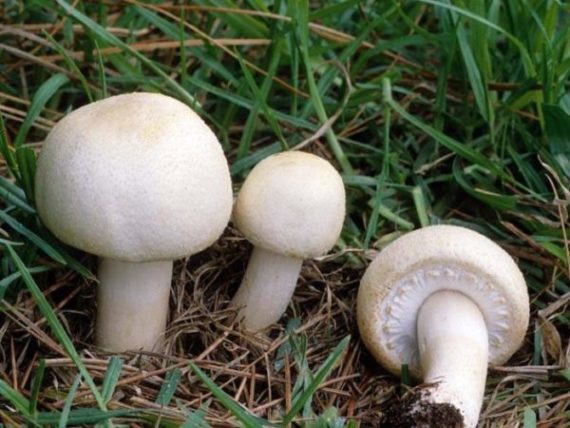 What does champignon look like?
What does champignon look like?
Champignon
Experienced mushroom pickers easily distinguish edible champignon from a poisonous mushroom, despite the external similarity of the legs.
Poisonous toadstool looks more like a false champignon. Its leg is yellowish. And if you break the cap, then yellow spots will appear along the edges of the fracture.
Green and greenish russula
The color and shape of the russula's cap resembles a toadstool. Therefore, you cannot be guided by this sign when collecting mushrooms. The main difference is the leg. In russula, it is straight. There is no ring, volva and tuberous thickening on it. In addition, the edible specimen has a pleasant smell, in contrast to the adult poisonous mushroom, which smells unpleasant.
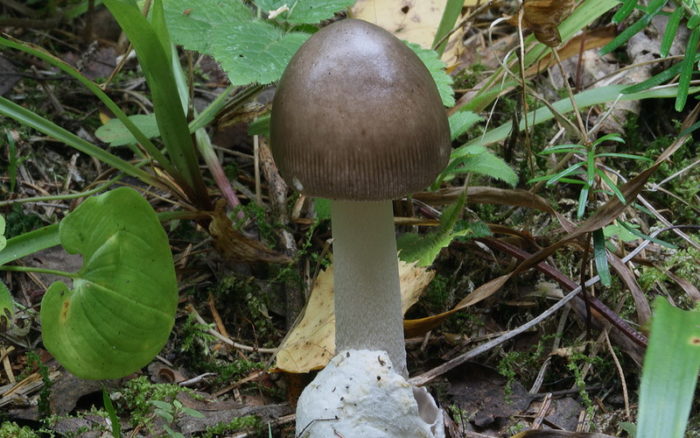 Float gray
Float gray
Float
This edible mushroom is outwardly unattractive and looks like a toadstool. This feature often misleads even experienced mushroom pickers. The main difference is the presence of a thin leg without a characteristic ring and a dirty gray hat with uneven edges. If damaged, the color of the pulp does not change.In addition, the float is smaller. Inhabits mixed or deciduous forests.











































